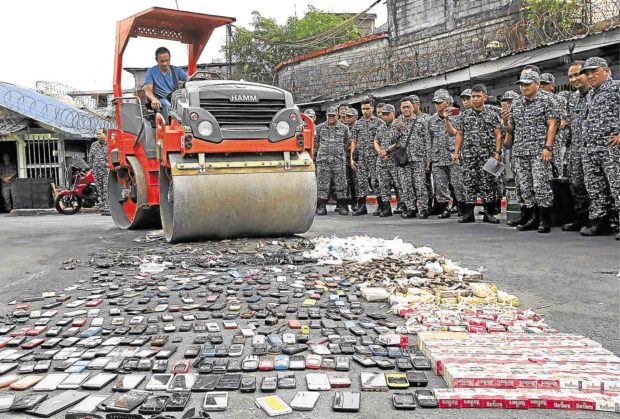
FLATTENED Banned items seized from Manila City Jail inmates during surprise quarterly inspections are destroyed by a steamroller on the prison grounds on Tuesday. —MARIANNE BERMUDEZ
MANILA, Philippines — As officials from the Bureau of Jail Management and Penology (BJMP), Philippine National Police, Philippine Drug Enforcement Agency (PDEA) and local government looked on, a steamroller flattened not pavement, but contraband seized from Manila City Jail (MCJ) inmates on Tuesday morning.
The items that were crushed on the grounds of one of the world’s most congested jails consisted of over 300 cell phones; 6,000 sticks of cigarettes or “yosi” and countless improvised weapons.
Of the 300 cell phones, 47 were smartphones. Most of the cigarettes were brand-label tobacco, still in their packs. Surprisingly, no drugs were found.
Makeshift knives
A lot of the improvised weapons, on the other hand, were pieces of wood or metal that had been sharpened.
These were confiscated from the city jail’s nearly 8,000 inmates through surprise quarterly inspections conducted under “Oplan Linis Piitan” by the BJMP, PNP and PDEA.
The contraband represented the team’s haul for a year. The quarterly surprise inspections were also part of the jail’s intensifying crackdown on contraband, according to Police Capt. Jayrex Bustinera, BJMP-Manila spokesperson.
These served as a reminder to inmates that banned items would inevitably be found and destroyed, he said.
Bustinera added that most of the time, the contraband were smuggled into the jail by visitors through disingenuous means, including hiding them in their private parts or mixing them with food. In one particular instance, however, a jail guard was caught hiding an inmate’s cell phone.
Change of venue
In previous years, all the seized items would be taken to the BJMP regional headquarters in Quezon City where these would be destroyed, he said.
Tuesday, however, marked the first time the destruction was done on the MCJ grounds.
“This was to assuage perceptions that the seized contraband were either recycled, returned to the inmates, or even taken advantage of (by jail officers),” Bustinera said. “At least when you destroy the contraband in front of them, you also shut down such perceptions.”